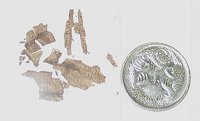Buddhist scrolls at one
with carbon dating
Jacquie van Santen
ABC Science Online
Rare manuscripts dubbed the 'Dead Sea Scrolls of Buddhism' are
indeed from the 1st and 5th centuries AD, carbon dating shows.
The manuscripts, which were written on fragile birch bark, provide
an important insight into the development of Buddhist literature
and help fill the gaps in some areas of Buddhist history.
Buddhism was traditionally a spoken tradition and until now,
little has been known about how it developed from the spoken to
the written word.
While Buddhism flourished throughout Asia, it disappeared from
India, Central Asia and the Indonesian archipelago, taking with
it many literary traditions.
"When we first learnt about these manuscripts we looked
at the scripts and the language and made a rough estimate of their
approximate age," says Dr Mark Allon, from the University
of Sydney, an Australian researcher who is translating the
text.
Carbon dating, conducted by researchers from the Australian
Nuclear Science and Technology Organisation, confirmed the
assessment.
The scientists used the process of accelerator mass spectrometry
to radiocarbon date the bark on which the manuscipts were written.
This process counts the rare carbon-14 isotopes in a sample and
uses this to calculate the sample's approximate age based on the
radioactive decay over time.
Two manuscripts from the Senior collection, which is named after
the scrolls' British owner, date to between 130 and 250AD
And three manuscripts from the Schøyen text, named after
the scrolls' Norwegian owner, date to between the 1st and 5th
century AD.
Allon says the Senior collection dating is particularly important
because it makes a major contribution to Indian Buddhism chronology.
 "One of the manuscripts we studied was found in a pot with
an inscription on it indicating that it was donated in the year
12. While it didn't say what era that was, the characteristics
of the inscription tell us that it must refer to the Kanishka
era."
"One of the manuscripts we studied was found in a pot with
an inscription on it indicating that it was donated in the year
12. While it didn't say what era that was, the characteristics
of the inscription tell us that it must refer to the Kanishka
era."
Kanishka was a very important king in northern India in about
the 1st or 2nd century AD, but the dates he lived and ruled have
been debated for a century or more.
Bark sample next to Australian 5c coin for comparison
(Image: ANSTO)
"What the carbon dates told us was that the earlier date
favoured by some scholars, namely 78AD, is no longer tenable because
the carbon dates tell us that the manuscripts actually dated from
130AD to 250AD."

The manuscripts are believed to have originated from Afghanistan
and are among many archaeological artefacts that were sold on
the international market in times of war.
http://www.abc.net.au/science/news/stories/s1587489.htm